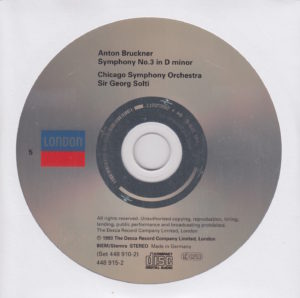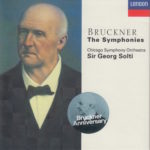 This morning’s conductor of Anton Bruckner’s Symphony No. 3 in D Minor (WAB 103), nicknamed “Wagner,” is Hungarian-born Sir Georg Solti (1912-1997), an artist with a long and noteworthy career.
This morning’s conductor of Anton Bruckner’s Symphony No. 3 in D Minor (WAB 103), nicknamed “Wagner,” is Hungarian-born Sir Georg Solti (1912-1997), an artist with a long and noteworthy career.
Doubt me?
Read this from the entry on Wikipedia titled “Georg Solti discography”:
The conductor Sir Georg Solti recorded throughout his career for the Decca Record Company. During the 1950s and 1960s Decca had an alliance with RCA Records in the USA and some of Solti’s recordings were first issued on the RCA label.
Solti’s first recordings were as a piano accompanist, playing at sessions in Zurich for the violinist Georg Kulenkampff in 1947. Decca’s senior producer, Victor Olof, did not much admire Solti as a conductor (nor did Walter Legge, Olof’s opposite number at EMI’s Columbia Records), but Olof’s younger colleague at Decca John Culshaw held Solti in high regard. With Culshaw, and later James Walker, producing his recordings, Solti’s career as a recording artist flourished.
Solti’s most celebrated recording was Wagner’s Der Ring des Nibelungen made in Vienna, with Culshaw producing, between 1958 and 1965. It has twice been voted the greatest recording ever made, the first poll being of readers of Gramophone magazine in 1999, and the second of professional music critics in 2011, carried out for the BBC.
For Decca, Solti made more than 250 recordings, including 45 complete opera sets. Among the international honours given for his recordings were 31 Grammy awards – more than any other recording artist, whether classical or popular.
One cannot be a schlub and have a massive list of recordings – including “the greatest recording of all time” – to his/her credit.
“The greatest recording of all time” – an amazing distinction, wot? An article about it can be found on the Classical Source web site, which (in part) reads:
Sir Georg Solti’s recording of Wagner’s Ring Cycle has been voted the greatest recording of all time in a close-run poll of the country’s leading classical music critics, carried out by BBC Music Magazine.
Of the 50 discs voted for, just 18 were recorded after 1965, one being Sir Simon Rattle’s 1988 production of Porgy and Bess which took the No. 10 slot. British conductor Rattle is the only major figure still seen on the rostrum today to make the Top 50, while the most recent recording is Alexander Melnikov’s 2010 Preludes & Fugues album, which was a BBC Music Magazine Award winner in 2010, and came in at No. 32 in the poll. With the majority of the best-ranked recordings dating from the 1950s and ’60s, it seems that the ‘golden age’ of recording really was golden.
The 50 greatest recordings of all time will be published in the January issue of BBC Music Magazine, on sale 21 December, priced £4.80.
 I first encountered Sir Georg Solti on Day 14 and on Day 30 of my 144-day project.
I first encountered Sir Georg Solti on Day 14 and on Day 30 of my 144-day project.
Here are the nuts and bolts (the objective aspects) of this morning’s listening experience:
Bruckner’s Symphony No. 3 in D Minor, composed in 1873
Sir Georg Solti conducts
The version Sir Georg chose is the 1877 version, ed. by Nowak
Chicago Symphony Orchestra plays
The symphony clocks in at 59:33
This was recorded in November of 1992 in Orchestra Hall in Chicago
Sir Georg was 80 when he conducted it
Bruckner was 49 when he composed it
This recording was released on the Decca/London record label
Bruckner wrote his symphonies in four parts. The time breakdown of this one (Symphony No. 3 in D Minor, 1877 version), from this particular conductor (Solti) and this particular orchestra (Chicago Symphony Orchestra) is as follows:
Moderato (Mehr bewegt, misterioso, officially)………………………….18:59
Andante (Bewegt, feirlich,quasi Adagio, officially)………………………15:36
Scherzo (Ziemlich schnell) ……………………………………………………………7:03
Finale: Allegro……………………………………………………………………………….14:23
Total: 59:33
Okay. Now for the subjective stuff…
My Rating:
Recording quality: 5
Overall musicianship: 5
CD liner notes: 4 (extensive essays about Bruckner and his symphonic style in German, French, English, and what appears to be Portuguese – however, no mention of the record label anywhere in its 56 pages, nor is there adequate information about the version used. Which version isn’t usually mentioned.)
How does this make me feel: 5
Everything about this performance screams “classy.” This is so well played, so beautifully recorded.
The brass is not brassy.
The orchestra is lush, powerful, and emotive.
The tempo is neither too fast nor too slow.
This is the kind of performance one hears on Classical radio stations with discerning DJs at the helm.
Or, better yet, this is the kind of performance one hears in person when all the stars are aligned and the Wayback Machine is set for 20-30 years ago.
I could get lost in this recording.
And did – for hours.
